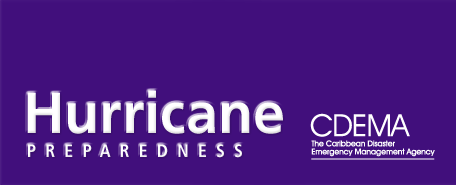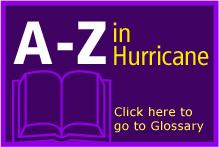|
|
Glossary
There are 83 entries in this glossary.| Term | Definition |
|---|---|
| Intertropical Convergence Zone |
The axis dividing the southeast trades from the northeast trades, toward which the surface winds tend to converge The easterly trade winds of both hemispheres converge at an area near the equator called the "Intertropical Convergence Zone (ICTZ)", producing a narrow band of clouds and thunderstorms that encircle portions of the globe. Aliases (separate with |): ITCZ
|
| Isobar |
The line drawn on a weather map connecting points of equal barometric pressure. |
| Jet Stream |
Relatively strong winds concentrated within a narrow current in the atmosphere. |
| Knot |
A unit for the measurement of speed in the nautical system. It is the nautical miles per hour. One knot is equivalent to 1.151 statute miles. |
| Landfall |
The term used to describe where the hurricane eye actually passes over land, usually used to describe the continental States rather than islands in the Caribbean. |
| Latitude |
The location north or south in reference to the equator, which is designated at zero (0) degrees. Parallel lines that circle the globe both north and south of the equator. The poles are at 90 degrees North and South latitude. |
| Longitude |
The location east or west in reference to the Prime Meridian, which is designated as zero (0) degrees longitude. The distance between lines of longitude are greater at the equator and smaller at the higher latitudes, intersecting at the earth's North and South Poles. Time zones are correlated to longitude. |
| Low-pressure System |
An area of a relative pressure minimum that has converging winds and rotates in the same direction as the earth. This is counterclockwise in the Northern Hemisphere and clockwise in the Southern Hemisphere. Also known as an cyclone, it is the opposite of an area of high pressure, or a anticyclone. See closed low, cold low, and cut-off low for further examples. |
| Millibar |
A metric measurement of atmospheric pressure used by weather services. Standard surface pressure is 1,013.2 millibars. |
| National Hurricane Center |
A Branch of the Tropical Prediction Center under the US National Weather Service, it is responsible for tracking and forecasting tropical cyclones over the North Atlantic, Caribbean, Gulf of Mexico, and the Eastern Pacific. Aliases (separate with |): NHC
|
| National Oceanic and Atmospheric Adminis |
An Administration of the U.S. Department of Commerce, it is the parent organization of the National Weather Service. It promotes global environmental stewardship, emphasizing atmospheric and marine resources. Aliases (separate with |): NOAA
|
| Nautical Mile |
A unit of length used in marine navigation that is equal to a minute of arc of a great circle on a sphere. One international nautical mile is equivalent to 1,852 meters or 1.151 statue miles. Refer to a sea mile. |
| Pressure |
The force per unit area exerted by the weight of the atmosphere above a point on or above the earth's surface. Also known as atmospheric pressure or barometric pressure. |
| Saffir-Simpson Damage-Potential Scale |
A scale, developed in the early 1970s by Herbert Saffir, a consulting engineer, and Robert Simpson, then Director of the National Hurricane Center, to measure the intensity of a hurricane from 1 to 5. The scale categorizes potential damage based on barometric pressure, wind speeds, and storm surge. Scale numbers are available to public safety officials when a hurricane is within 72 hours of landfall. Scale assessments are revised regularly as new observations are made. Public safety organizations are kept informed of new estimates of the hurricane's disaster potential. In practice, sustained surface wind speed (1-minute average) is the parameter that determines the category since storm surge is strongly dependent on the slope of the continental shelf. |
| Small Craft Advisory |
An advisory issued for marine interests, especially for operators of small boats or other vessels. Conditions include wind speeds between 37 kph (23 mph) and 63 kph (39 mph). Issued up to 12 hours ahead of conditions. |


























